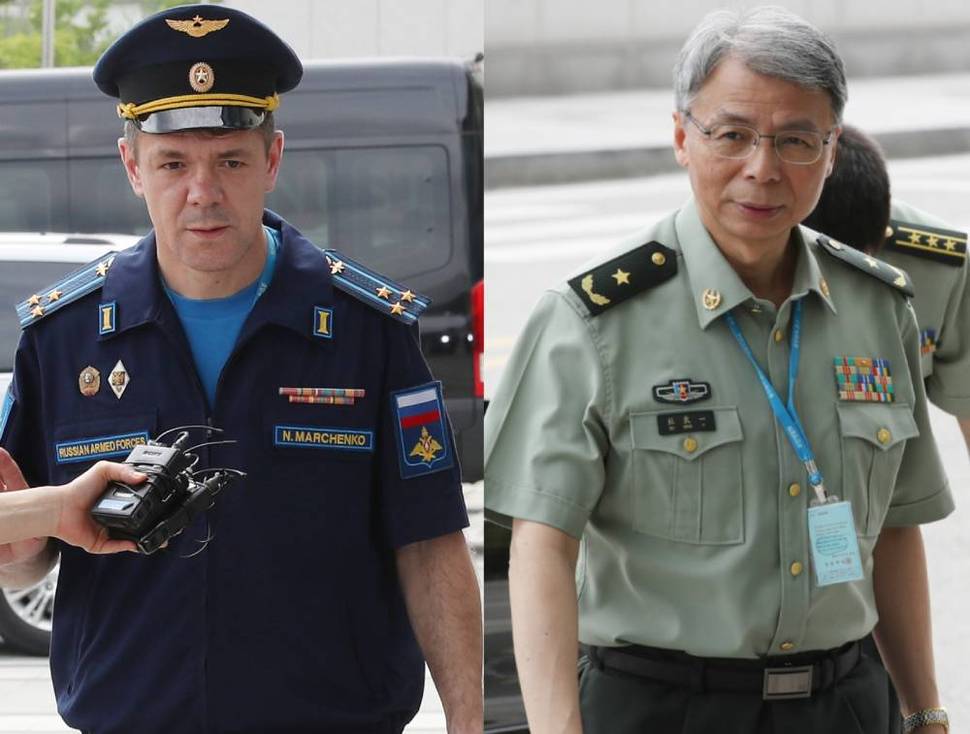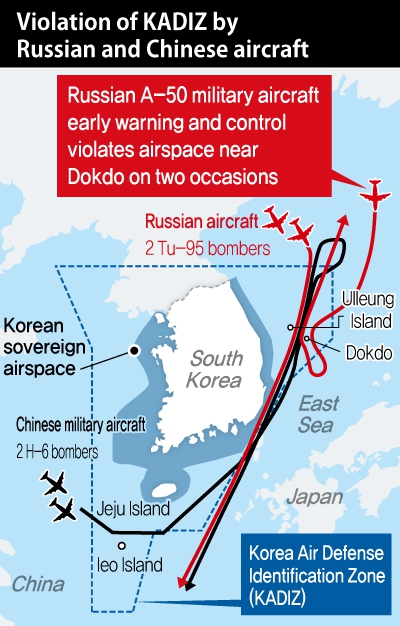Posted on : Jul.24,2019 15:59 KST
Modified on : Jul.24,2019 16:33 KST
 |
|
Russian Deputy Military Attache Nikolai Marchenko (left) and Du Nongyi (right), military attache of the Chinese Embassy in Seoul, are summoned to South Korean Joint Chiefs of Staff (JCS) building over the violation of South Korean airspace by Russian and Chinese aircraft on July 23. (Yonhap News)
|
Move seen as strategy to curb US influence in region
Russia and China’s unauthorized entry into the Korea Air Defense Identification Zone (KADIZ) during their first joint long-range patrol aircraft exercises on July 23, and the violation of South Korean airspace near Dokdo by a Russian early warning and control (reconnaissance) aircraft, are being interpreted as an attempt by the two countries to curb the US-led strategy in the Indo-Pacific region. That aim can also be seen in a statement by the Russian government describing the joint flight as a “scheduled exercise” for the sake of “global stability and increased cooperation.”
 |
|
Violation of KADIZ by Russian and Chinese aircraft
|
This is not the first time Chinese and Russian military aircraft have entered the KADIZ without authorization. Such entries have become more frequent over time – and the aircraft’s flight activities more aggressive. In 2017, as frictions between Seoul and Beijing over the deployment of a Terminal High Altitude Area Defense (THAAD) system on the Korean Peninsula were reaching a fever pitch, Chinese military aircraft entered KADIZ in January and December. Last year, Chinese military aircraft flew into the KADIZ no fewer than eight times. The most recent incident occurred on Feb. 23, when controversy erupted over a suspected Chinese reconnaissance aircraft’s irregular flight path taking it between Ulleung Island and Dokdo.
Furthermore, the South Korean government previously protested KADIZ intrusions by Russian military aircraft in August 2017, July 2018, and June of this year. With the UN Command recently reported to be pursuing a plan to include Japan among the countries from which it would receive military forces in the event of a crisis on the Korean Peninsula, the latest joint exercises between China and Russia are also being seen as a bid to check the US’ expansion of military strength in Northeast Asia through a stronger alliance with Japan.
On July 23, China and Russia had their first-ever long-range joint patrol aircraft exercises, with four military aircraft crossing into the South Korean and Japanese air defense identification zones. Experts see their aim as being to broaden the operational radius of their bombers’ joint exercises beyond the East Sea into the South China Sea – increasing their ability to respond jointly to the US-led strategy in the Indo-Pacific region.
“China and Russia are operating in a de facto alliance against the US’ Indo-Pacific strategy,” concluded Lee Su-hyeong, a senior research fellow at the Institute for National Security Strategy (INSS).
“Russia, which has been facing US and European sanctions since annexing part of Ukraine in 2014, has joined forces with China, which is in conflict with the US over issues involving the South China Sea, trade, and technological dominance, and their relationship of military cooperation has intensified sharply since around 2016,” Lee explained.
A military source said the US “wants to establish an agreement with India to block China in the southwest, one with Japan to block it in the east, and it also wants to strengthen its alliance with South Korea.”
“With its recent announcement of plans to sell weapons to Taiwan, the US is trying to encircle China in all directions, including the South China Sea,” the source explained.
Analysts also saw the activity as indirectly targeting White House National Security Advisor John Bolton’s visits to South Korea and Japan by serving as a check against the US’ joint military exercises scheduled to begin with South Korea in early August. Kim Jongdae, a Justice Party lawmaker and military affairs expert said, “In the past, there was a hotline set up between South Korea and China at the air force operational command level to discuss air defense issues, but that military hotline has been suspended since the THAAD dispute.”
“There have always been joint Chinese-Russian exercises, but this one was of a different nature. We could see a return of the tired old Northeast Asian geopolitical conflicts,” he fretted.
Russia denies violating territorial airspace; may be exploiting S. Korea-Japan conflict
But with the Russian government claiming it did not violate territorial airspace, questions remain as to whether Russia did indeed intend to violate airspace around Dokdo. Differing analyses have been offered, with some observers suggesting the aircraft may have entered territorial airspace by mistake during the KADIZ flight and taken a sharp turn south after the South Korean Air Force fired their warning shots.
“It doesn’t appear certain whether the Russian early warning aircraft deliberately violated airspace or violated it by accident during its KADIZ flight,” said Moon Jang-ryul, a professor at Korea National Defense University.
Choi Yong-hwan, director of the security strategy research office at INSS, said, “Given that there are few issues where South Korea and Russia are intertwined in terms of security issues, it’s unlikely that this was a deliberate provocation against South Korea.”
“I think we should view [the airspace violation] as an unusual development and keep an eye on the situation,” Choi suggested.
“What is clear is that it’s a serious situation when Chinese and Russian military aircraft are doing joint maneuvers over the East Sea,” he added.
Other analysts suggested Russia’s aim was to create fissures in South Korean, US, and Japanese military cooperation framework by fueling the recently intensifying conflict in South Korea-Japan relations.
“I suspect that Russia’s unusual violation of airspace may have been an attempt to stir up further chaos in South Korea-US relations amid Japan’s refusal to recognize South Korea’s dominion over Dokdo,” said a military source.
By Noh Ji-won and Park Min-hee, staff reporter
Please direct comments or questions to [english@hani.co.kr]










